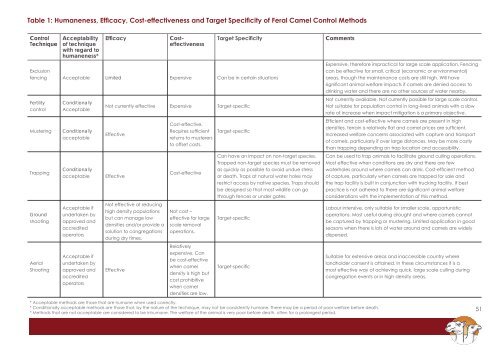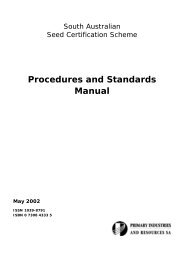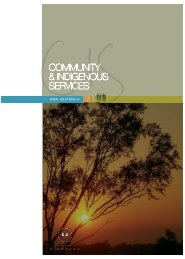Final May 22 Bes Practice Camel Book_web_part1 - Rural Solutions ...
Final May 22 Bes Practice Camel Book_web_part1 - Rural Solutions ...
Final May 22 Bes Practice Camel Book_web_part1 - Rural Solutions ...
- No tags were found...
You also want an ePaper? Increase the reach of your titles
YUMPU automatically turns print PDFs into web optimized ePapers that Google loves.
Table 1: Humaneness, Efficacy, Cost-effectiveness and Target Specificity of Feral <strong>Camel</strong> Control MethodsControlTechniqueAcceptabilityof techniquewith regard tohumaneness*EfficacyCosteffectivenessTarget SpecificityCommentsExclusionfencing Acceptable Limited Expensive Can be in certain situationsExpensive, therefore impractical for large scale application. Fencingcan be effective for small, critical (economic or environmental)areas, though the maintenance costs are still high. Will havesignificant animal welfare impacts if camels are denied access todrinking water and there are no other sources of water nearby.FertilitycontrolConditionallyAcceptableNot currently effective Expensive Target-specificNot currently available. Not currently possible for large scale control.Not suitable for population control in long-lived animals with a slowrate of increase when impact mitigation is a primary objective.MusteringConditionallyacceptableEffectiveCost-effective.Requires sufficientreturns to musterersto offset costs.Target-specificEfficient and cost-effective where camels are present in highdensities, terrain is relatively flat and camel prices are sufficient.Increased welfare concerns associated with capture and transportof camels, particularly if over large distances. <strong>May</strong> be more costlythan trapping depending on trap location and accessibility.Can have an impact on non-target species.Can be used to trap animals to facilitate ground culling operations.Trapped non-target species must be removedMost effective when conditions are dry and there are fewTrappingConditionallyacceptableEffectiveCost-effectiveas quickly as possible to avoid undue stressor death. Traps at natural water holes maywaterholes around where camels can drink. Cost-efficient methodof capture, particularly when camels are trapped for sale andrestrict access by native species. Traps shouldthe trap facility is built in conjunction with trucking facility. If bestbe designed so that most wildlife can gopractice is not adhered to there are significant animal welfarethrough fences or under gates.considerations with the implementation of this method.GroundshootingAcceptable ifundertaken byapproved andaccreditedoperatorsNot effective at reducinghigh density populationsbut can manage lowdensities and/or provide asolution to congregationsduring dry times.Not cost –effective for largescale removaloperations.Target-specificLabour intensive, only suitable for smaller scale, opportunisticoperations. Most useful during drought and where camels cannotbe captured by trapping or mustering. Limited application in goodseasons when there is lots of water around and camels are widelydispersed.RelativelyAerialShootingAcceptable ifundertaken byapproved andaccreditedoperatorsEffectiveexpensive. Canbe cost-effectivewhen cameldensity is high butcost prohibitivewhen camelTarget-specificSuitable for extensive areas and inaccessible country wherelandholder consent is attained. In these circumstances it is amost effective way of achieving quick, large scale culling duringcongregation events or in high density areas.densities are low.* Acceptable methods are those that are humane when used correctly.* Conditionally acceptable methods are those that, by the nature of the technique, may not be consistently humane. There may be a period of poor welfare before death.* Methods that are not acceptable are considered to be inhumane. The welfare of the animal is very poor before death, often for a prolonged period.51







